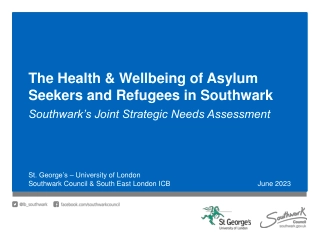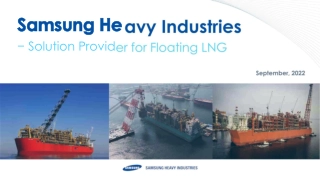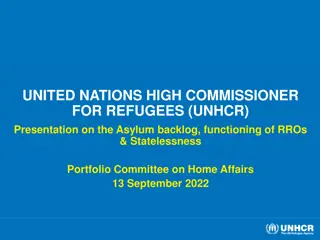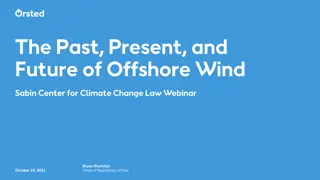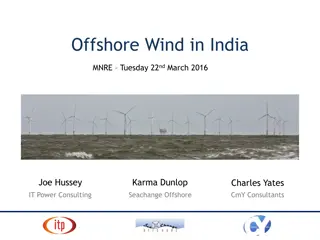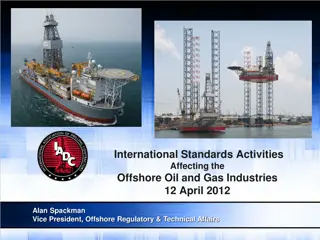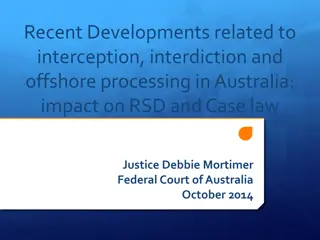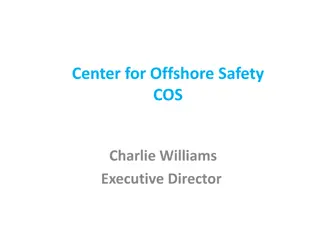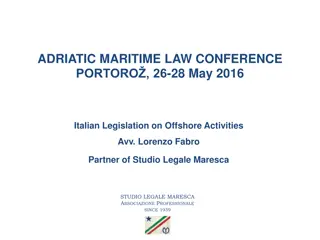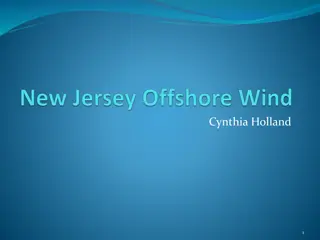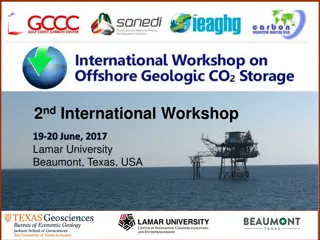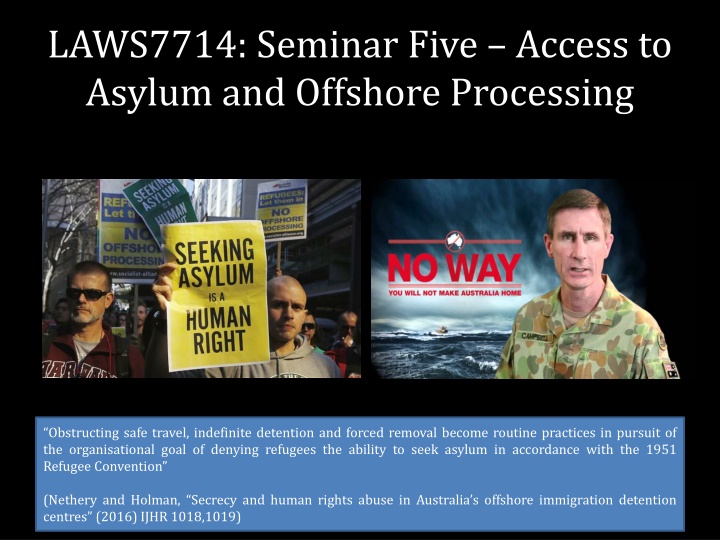
Offshore Processing and Denying Asylum: Operation Sovereign Borders
Learn about the practices obstructing safe travel and denying refugees asylum in Australia through the militarized approach of Operation Sovereign Borders, including turning back asylum seekers and offshore processing in Nauru and Papua New Guinea.
Download Presentation

Please find below an Image/Link to download the presentation.
The content on the website is provided AS IS for your information and personal use only. It may not be sold, licensed, or shared on other websites without obtaining consent from the author. If you encounter any issues during the download, it is possible that the publisher has removed the file from their server.
You are allowed to download the files provided on this website for personal or commercial use, subject to the condition that they are used lawfully. All files are the property of their respective owners.
The content on the website is provided AS IS for your information and personal use only. It may not be sold, licensed, or shared on other websites without obtaining consent from the author.
E N D
Presentation Transcript
LAWS7714: Seminar Five Access to Asylum and Offshore Processing Obstructing safe travel, indefinite detention and forced removal become routine practices in pursuit of the organisational goal of denying refugees the ability to seek asylum in accordance with the 1951 Refugee Convention (Nethery and Holman, Secrecy and human rights abuse in Australia s offshore immigration detention centres (2016) IJHR 1018,1019)
Operation Sovereign Borders: Externalising Australia s border controls If you attempt to come to Australia by illegal maritime means, you will be turned around or taken back. If you are rescued at sea, you will be safely turned around and the most that you might hope for is to be taken to Papua New Guinea or Nauru for the purposes of being assessed and processed for potential settlement outside Australia or return to your country of origin. You will never settle in Australia. To those waiting in Indonesia, Sri Lanka, Vietnam, Pakistan, Afghanistan, Iraq, Syria and elsewhere, seeking to come to Australia by illegal maritime means, and who listen very carefully to what is said by ministers and senior officials, let me be very clear: The path is shut, with no exceptions. Senate, Legal and Constitutional Affairs Legislation Committee, Estimates, 8 February 2016, 3 (M Pezzullo, Secretary, Department of Immigration and Border Protection).
What is Operation Sovereign Borders (OSB)? OSB entails the militarisation of the border and comprises several inter-related measures: A. Regional processing and resettlement in Nauru, PNG (Manus Island/Port Moresby), & US; B. Covert maritime interdiction and turn-backs of asylum seekers to: Indonesia/Sri Lanka/Vietnam; C. operations; Overseas disruption of people smuggling D. communities in Australia, in source countries and in transit; and Communications campaign for diaspora E. Temporary protection visas for irregular maritime arrivals (2012-2013) granted asylum in Australia.
Historical Context: The MVTampa and the Pacific Solution (2001-07) 22 August 2001: Tampa sets sail for Singapore from Fremantle 26 August: Tampa rescues people from sinking boat 27 August: Australian authorities advise the Captain not to enter its territorial waters around Christmas Island 29 August: SAS board the vessel. The following day those on board petition for refugee protection pursuant to the 1951 Refugee Convention 3 September: passengers taken by HMAS Manoora to Nauru. 11 September 2001: North J finds that the Commonwealth acted illegally and ordered the release of the asylum seekers (VCCL v Minister for Immigration (2001) FCR 452. Decision is appealed to the FCA (Full Court). The MV Tampa carrying 433 asylum seekers rescued at sea from the stricken vessel, Palapa, in August 2001
Ruddock v Vadarlis (2001) 110 FCR 491 What supplied the Australian government with the legal power to interdict and detain asylum seekers at sea? Was the Commonwealth acting within non-statutory Executive power (s.61 Cth Constitution) when intercepting the Tampa? Specifically did the asserted (executive/prerogative) power to prevent the entry of non-citizens, and to do such ancillary things necessary to effect their exclusion, exist? If it did exist was it extinguished by virtue of the Migration Act which regulated the entry, presence and departure of non-citizens?
Ruddock v Vadarlis (2001) 110 FCR 491 French and Beaumont JJ held: The executive power of the Commonwealth did extend to a power to prevent entry of non-citizens and to to effect their exclusion; Executive power did extend to excluding non-citizens by preventing a vessel from docking at a port and to restraining persons/or boat from landing in Australia; Migration Act did not deprive the Government of the Executive power; Steps taken to effect interdictees departure from Australian waters were lawful: within the non-statutory executive power of Australian government (2001) 10 FCR 491 [176]-[191] [193]-[197], [201-204] (French J) - nature of executive power/gatekeeping function and key reasoning of the court Black CJ (dissenting): Doubted that the asserted executive (prerogative) power to exclude aliens continued to exist at common law: its existence was entirely uncertain, and no previous modern instances of its exercise; and the Migration Act evinced an intention to cover the field, regulating: the coming into, and presence of, non-citizens in Australia (s.4). Accordingly, the statute displaced the asserted executive power (at common law). (2001) 10 FCR 491 [8]-[29], [42]-[47], [60]-[64], [126]. See P Billings, Refugees, the rule of law and executive power: A(nother) case of the conjuror srabbit? (2003) 54 Northern Ireland Legal Quarterly 412 (analysing the Tampa case).
Post Tampa: the Pacific Solution (2001-08) What were the law/policy responses to boat arrivals in Australia post Tampa (2001-08)? Regional arrangements for processing refugee claims (lodged by maritime arrivals) on Nauru Offshore Processing: New Excision of territory from the migration zone Operation Relex: maritime interception and turnaround of boats bearing asylum seekers Regional Processing Centre on Nauru (2001-08) Temporary Protection Visas (1999-2007) for unauthorised maritime arrivals (refugees)
Excision Laws: Purpose and effect of a legal fiction? Migration laws decouple Australian territory from migration zone . Physical presence on Australian soil does not equate to legal presence in Australia Purpose is to deprive asylum seekers of substantive and procedural rights arising under the Migration Act and deter future putative refugees Remote islands (Christmas Island, Cocos Islands) were first excised in 2001, removed from the migration zone, meaning people were barred from making a valid protection visa application In 2013 legislative reforms - Migration Amendment (UMA) Act - excised the Australian mainland from the migration zone so any irregular (visa-less) arrivals reaching the mainland cannot apply for a visa on arrival: they are liable to be sent offshore for regionalprocessing and overseas resettlement. See, A Vogl, Over the Borderline: A Critical Inquiry into the Geography of Territorial Excision (2015) 38(1) UNSW LJ 114.
No advantage principle (2012) What was the noadvantage principle (2012-13) and the motivation behind it, and relatedly OSB (2013-18)? Deterrence was the central element referable to (a) the illegal act of seeking asylum (without a visa) and (b) humanitarianism (preventing loss of life at sea). A priority for the HoustonPanel was: [T]o recalibrate Australian policy settings to achieve an outcome that asylum seekers will not be advantaged if they pay people smugglers to attempt dangerous irregular entry into Australia instead of pursuing regular migration pathways and international protection arrangements as close as possible to their country of origin The Houston Panel - Report of the Expert Panel on Asylum Seekers (2012) Led to passage of the Regional Processing Act (2012) Go here for an ABC Four Corners report from April 2013 on the resuscitation of offshore processing
Regional Processing Act (Cth) (2012): Establishing Refugee Camps (or, Prisons) Australian government s statutory power to designate regional processing countries (RPCs) was conditioned by a broad discretionary ( national interest ) requirement & political assurances that refugee law would be complied with in RPCs. The statutory (designation) power was unconditioned by international (refugee) law obligations or the regional processing country s domestic laws or international obligations Transfer of legal responsibility: Regional Processing Act (2012) made no provision for what was to happen to maritime arrivals after their transfer overseas which was a matter for the domestic law of a designated RPC. Neo-colonialism? Large transfers of funds/foreign aid to RPCs Manus island centre: a gulag within which Australian state agencies, through an opaque and complex chain of command, wield control over detainees basic means of survival, their daily routines and the key decisions affecting their lives. M Grewcock, Our lives is in danger : Manus Island and the end of asylum (2017) 59(2) Race and Class 70, 76. PNG detainees pictured above prior to closure of the Manus Island centre in 2017
Legality of offshore processing tested before the Before the HCA: Plaintiff S156/2013 v Minister for Immigration and Border Protection(2014) 254 CLR 28 Australian government s offshore regional processing arrangements with PNG were deemed to be legally valid, supported by both legislation (s 198AB 198AD Migration Act) and those laws were valid under the Australian Constitution (s 51 (xix)because they were in respect of a class of aliens. The High Court expressed doubts as to whether the new regional processing laws were consistent with Australia s obligations under the Refugee s Convention: The plaintiff relies on what was said in Plaintiff M61/2010E v The Commonwealth (2010) about the Migration Act more generally. It was said [in M61] that, read as a whole, the Migration Act contains an elaborated and interconnected set of statutory provisions directed to the purpose of responding to the international obligations which Australia has undertaken in the Refugees Convention and the Refugees Protocol . [ ] There may be some doubt whether the provisions of subdiv B, which were inserted after these cases, can be said to respond to Australia s obligations under the Refugees Convention. Plaintiff S156/2013 (2014) 254 CLR 28, 47 [39]-[44].
Legality of offshore processing tested before the Plaintiff M68-2015 v Minister for Immigration and Border Protection (2016) 257 CLR 42, 60- 65, 67-73 (French CJ, Kiefel and Nettle JJ). A Bangladeshi asylum seeker argued that the government had acted illegally by participating in a practical sense (procuring and funding) with her detention in Nauru. HCA ruled offshore arrangements with Nauru were legal. The HCA found that laws authorising the Australian government to secure funding for and to participate in an asylum seeker s detention at the RPC on Nauru were valid laws under the Constitution (s 51(xix) (laws with respect to aliens) applying the principles in Plaintiff S156. Furthermore that s 198AHA of the Migration Act (which was inserted into the Act in 2015 (i.e. well after regional processing had begun in late 2012) retrospectively authorised the Australian government s conduct in relation to the plaintiff s detention during 2014. Section 198AHA(2) founded the government s participation in the detention of an alien (and restraint over liberty) for so long as was reasonably necessary to achieve the purpose of processing by Nauru of a person s refugee status claim.
Judicial consideration of offshore processing: Manus Island Before the PNG Supreme Court: Namah v Pato (2016) SC 1497 Deciding on the constitutionality of bi-lateral arrangements entered into in Sept 2012 and later (purportedly) validated by an amendment to the PNG Constitution s 42 (personal liberty) [5]-[7]. Detention centre is enclosed and manned by security officers to prevent people leaving; all funded by Australia [20]. In an effort to pre-empt a legal challenge to the legality of the detention arrangements, constitutional amendments were introduced in 2014: per s 42(1)(ga). [22] Prior to the 2014 amendments s 42(1) Constitution guaranteed individual liberty. Liberty could only be curtailed on specified grounds given effect through legislation [33] and [38]. Detention outside of that authorised by s 42(1) would be unconstitutional. Relevantly s 42(1)(g) Constitution was potentially applicable here; it addressed detention to prevent unlawfulentry or to facilitate removal.
Namah v Pato (2016) SC 1497 PNG Supreme Court held: that the forcible transfer to PNG and detention of asylum seekers was contrary to s 42(1)(g) Constitution: it was therefore unconstitutional. Refugees had entered on a lawful basis with a permit so detention unwarranted [39]. Also, the 2014 constitutional amendments (per s 42(1)(ga) were not validly made [53]-[54]. And there was no relevant enabling domestic law to regulate asylum seekers freedom of movement even if 2014 amendments had been validly introduced [56] and [59].
Offshore detention on Manus illegal I agree that treating those required to remain in the relocation centre as prisoners irrespectiveof their circumstances or their status save only as asylum seekers, is to offend against their rights and freedoms as guaranteed by the various conventions on human rights at international law and under the PNG Constitution. This position is aggravated by the lack of any Act of Parliament or a regulation promulgated under s. 23 of the Migration Act or any other law made for that purpose clearly specifying how the asylum seekers are to be treated, whilst having due regard to their rights and freedoms as guaranteed under the various international conventions and more so under the PNG Constitution. Image result for pictures of PNG detention centre Namah v Pato (2016) SC 1497 [69] (Kandakasi J). On the closure of Manus Island RPC go here and on the costs of offshore processing go here
Consequences of unlawful detention on Manus? Closureof detention centre (Oct 2017) Class action for false imprisonment: Majid Kamasee v Commonwealth (2017) Claim for negligence and false imprisonment (following PNG SC ruling) settled on 6 Sept 2017 with Supreme Court (Vic) ruling on compensation settlement agreement between the parties. Settlement ($70M): government agrees to compensate detainees to avoid going to trial go here. Alternative perspectives on the payout: Comment in the Sydney Morning Herald go here Australian government politicians response - go here
Legal responsibility for violations of international (human rights) law? Legal responsibility under international law for human rights violations: Considering that this situation is purposely engineered by Australian authorities to serve as a deterrent for potential future unauthorized maritime arrivals ( we stopped the boats ), considering the incredible hardship that most of these asylum seekers and refugees have already endured in their countries of origin and in transit countries on their way to Australia, and considering that Australian authorities have been alerted to such serious issues by numerous reports from international organizations such as the United Nations and civil society organizations, Australia s responsibility for the physical and psychological damage suffered by these asylum seekers and refugees is clear and undeniable. Fran ois Cr peau, Report of the Special Rapporteur on the Human Rights of Migrants on His Mission to Australia and the Regional Processing Centres in Nauru, UN Doc A/HRC/35/25/Add.3 (24 April 2017) pp 14-15. whileAustralia s offshore detention share many characteristics with prisons and other closed institutions, offshore detention centres have unique features that further jeopardise the human rights of detainees. (Nethery and Holman, Secrecy and human rights abuse in Australia s offshore immigration detention centres (2016) IJHR 1018,1023)
Violations of international human rights law? Lack of transparency: Would-be scrutineers including various UN rapporteurs, human rights organisations, journalists, and advocates, faced a number of structural barriers to entering either Nauru or PNG Parliamentary inquiries found that the RPC environments were unsafe generally particularly for children and regarded the mechanisms by which incidents were reported and investigated, to be inadequate Damaging living environment and lack of autonomy: The ongoing use of tented accommodation in Nauru has been a source of sustained criticism over many years, particularly in relation to the lack of privacy, and the unsuitability of these facilities in such a humid climate The allegations of abuse and neglect are prevalent and sustained. They indicate that refugees and asylum seekers in RPCs are living in an unsafe environment. The causal nexus between this unsafe living environment, including instances of abuse and neglect, and corresponding widespread mental health problems and self-harm, is indisputable. Inadequate health care and inadequate processes for medical transfers: as illustrated by Hamid Khazaei s case (2014). Go here for the coroner s report (30 July 2018). Durable solution and effective protection? Strong evidence indicating that when the RPCs became open centres , the damaging living environment has not improved, and that refugees and asylum seekers became exposed to new risks The Senate, Parliament of Australia, Serious allegations of abuse, self harm and neglect of asylum seekers in relation to the Nauru Regional Processing Centre, and any like allegations in relation to Manus Island Processing Centre (21 April 2017)
Offshore processing, human rights abuses and the lived experience This issue must be understood as the annihilation of human incarceration of human beings within the history of modern Australia; it is a long history, a comprehensive history, it is intertwined with its colonial history. the overwhelming weight of evidence points to an environment that is not adequate, appropriate or safe for the asylum seekers characterised by poor facilities; neglect of medical welfare and educational needs of detainees; dehumanising treatment by staff; widespread mental illness and rates of self-harm; and pervasive physical and sexual abuse of detainees including children beings, the detained there , Behrouz Boochani, I write from Manus Island as a duty to history 6 Dec 2017, The Guardian. Starvation, thirst and terror slowly but surely dominate the prison. Gradually these factors impose their power over the incarcerated refugees. Bodies are weak, muscles are fatigued, spirits are weary. It has been nearly five years full of anguish anguish that has ground everyone down. (Nethery and Holman, Secrecy and human rights abuse in Australia s offshore immigration detention centres (2016) IJHR 1018,1032) Behrouz Boochani, Manus is a landscape of surreal horror (2 Nov 2017), The Guardian.

